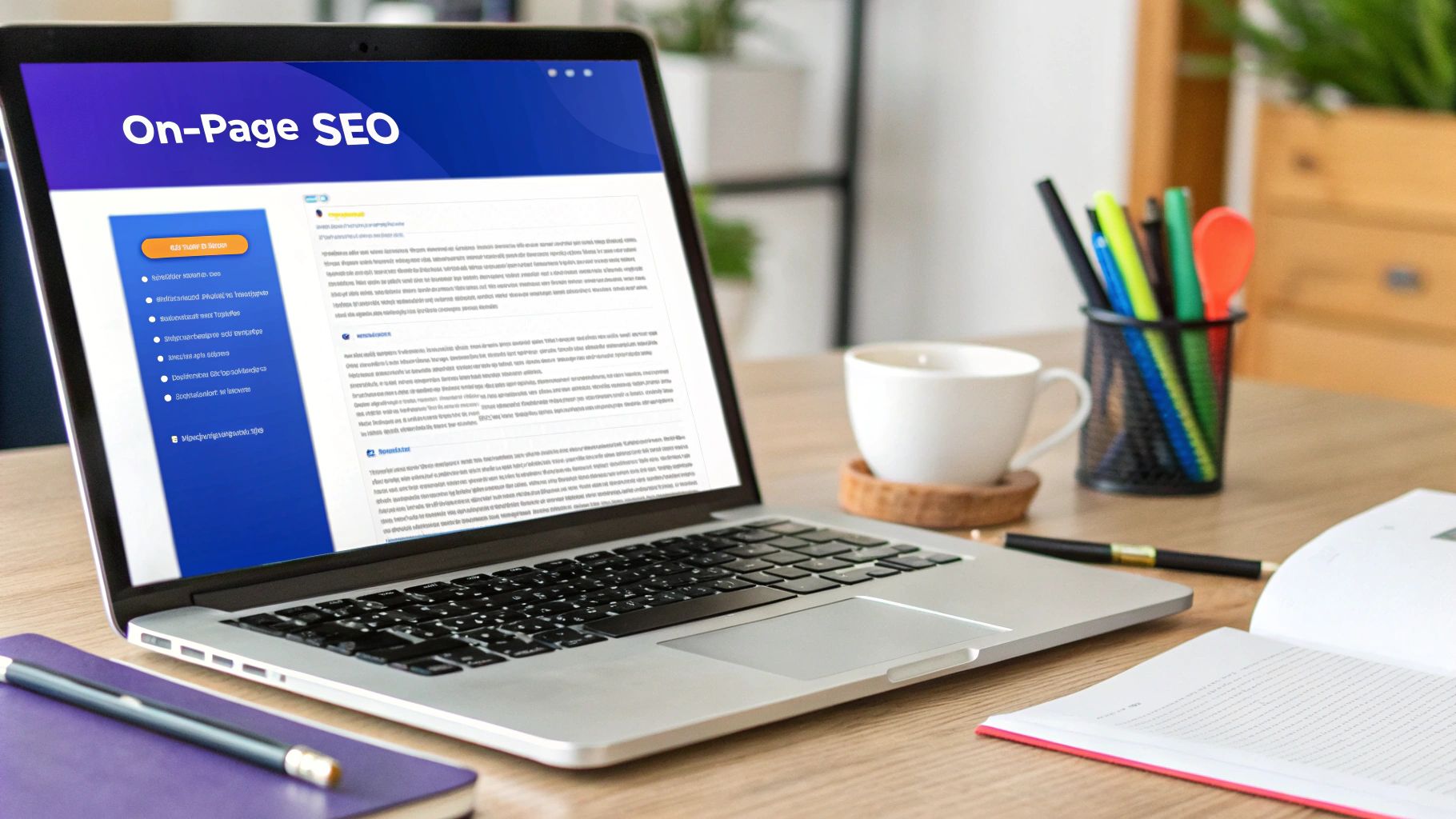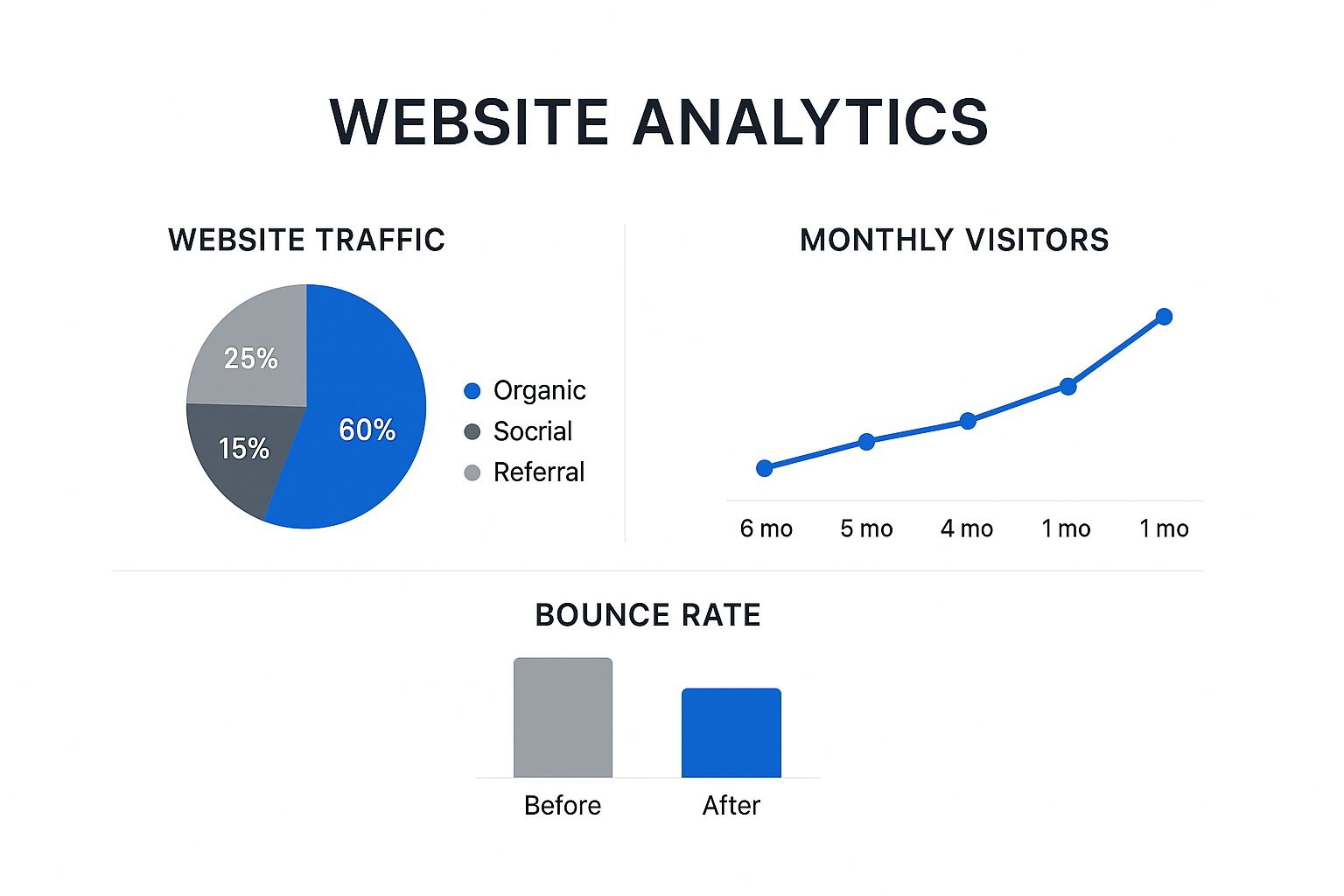
Trying to boost your website traffic is a bit like spinning plates. You've got to keep your search engine presence strong, create content people genuinely want to share, and then get that content in front of them across a bunch of different channels.
At its heart, it's about making your site both easy to find and genuinely valuable when people get there.
First, Figure Out Where You Stand
Before you dive headfirst into writing blog posts or launching ad campaigns, you need a clear picture of where you are right now. Jumping in without a baseline is like starting a road trip with no map; you'll be moving, but you'll have no idea if you're actually getting closer to your destination.
The goal here is to move past the vague idea of 'more traffic' and get a proper, measurable plan in place.
It all starts with a traffic audit. Tools like Google Analytics are your best friend here, giving you a detailed look at what’s actually happening on your site. Don't get distracted by flashy numbers like total page views. Instead, focus on the data that tells a story about what your visitors are doing.
Pinpoint Your Hits and Misses
Start by finding your greatest hits. In Google Analytics, head over to the 'Pages and screens' report. Which articles or landing pages are consistently pulling in the most organic traffic? These are your content pillars – the topics and formats that are clearly resonating with search engines and your audience. Make a note of what makes them work. Is it their depth? The specific keywords they target? The way they're structured?
Next, find the pages that aren't pulling their weight. These are the ones with hardly any traffic, a sky-high bounce rate, or where people leave after a few seconds. Do you see any patterns? Maybe they're targeting keywords that are just too competitive, or the content itself doesn't really answer the question someone was asking. This diagnosis is crucial – it tells you exactly where to focus your efforts first.
Set Goals That Actually Mean Something
Once you have a clear understanding of your current performance, you can set some meaningful objectives. A vague goal like "increase traffic" is pretty useless because you can't act on it. What you need is a SMART goal – specific, measurable, achievable, relevant, and time-bound.
A good objective isn't just about boosting the numbers; it’s about attracting the right kind of visitor. A well-defined goal ensures every single thing you do next, from keyword research to content promotion, is pulling in the same direction and you’re not just wasting your effort.
For example, a UK-based e-commerce business selling handmade furniture might set a goal like this: "Increase organic traffic from UK audiences by 20% over the next six months by optimising our top ten underperforming product category pages."
This goal actually works because it gives you:
- Specificity: It targets organic traffic from a specific country (UK).
- Measurability: The 20% increase is a clear benchmark for success.
- Actionability: It gives you a clear starting point—optimise those ten specific pages.
- Relevance: It focuses on attracting a qualified audience who are actually likely to buy something.
- Time-Bound: The six-month timeframe creates a deadline and a point to review your progress.
Getting this foundation right changes everything. You stop reacting and start being strategic. Every piece of content you create and every tweak you make will now serve a clear purpose, helping you build steady, long-term growth.
Master On-Page SEO to Win Organic Search

Think of on-page SEO as getting the foundations right. It’s all the stuff you do on your own website to show Google what you're about and why you deserve to rank. It's not about secret tricks; it's about making your site genuinely useful for people and easy for search engines to understand.
Get this right, and you build a solid base for consistent, long-term traffic. Ignore it, and you’re basically building on sand. Let’s get stuck into the practical bits that actually move the needle.
Conduct Keyword Research That Matters
The first mistake most businesses make? Guessing what people search for. You need to know the exact language your customers are using when they need what you sell. Forget chasing broad, hyper-competitive terms. The real gold is in keywords that show someone's ready to act.
A local Glasgow bakery targeting just "cakes" is going to get lost. But what about "best birthday cakes in Glasgow"? That’s someone with their wallet out. Tools like Semrush are great for this, but even Google’s own Keyword Planner will uncover gems.
- Long-tail keywords: These are longer phrases (think three words or more) and they're brilliant. Less competition, and the people searching them know exactly what they want.
- Local keywords: Simple but so effective. "Web design Midlothian" is a classic example that pulls in local customers.
- Question-based keywords: Think "how much does a website cost?" Answering these directly makes you the expert and builds trust instantly.
Craft Compelling Titles and Descriptions
Your title tag and meta description are your shop window in the Google results. It’s the first thing anyone sees. If it's boring or irrelevant, they'll scroll right past, even if your page is exactly what they need. A good click-through rate tells Google your page is a great match.
Keep your title tag under 60 characters, get your main keyword in there, and make it interesting.
Key Takeaway: Your title and description are a mini-advert. Don't just stuff them with keywords; write them for humans. Tell them exactly why they should click your link over all the others.
So instead of a dull title like "Plumbing Services," try "Emergency Plumber in Edinburgh | 24/7 Call-Outs | Fixed Prices." It instantly solves problems and sets expectations.
Optimise Your URLs and Images
These are the details people often skip, but they make a real difference to both search engines and the people using your site. Small tweaks here add up to big gains.
Create Clean SEO-Friendly URLs
A good URL should make sense if you read it out loud. It needs to be short, descriptive, and contain your main keyword. It helps everyone understand what the page is about before they even click.
- Bad URL:
yourwebsite.co.uk/p?id=123 - Good URL:
yourwebsite.co.uk/services/emergency-plumbing
Optimise Images for Speed and Context
Huge image files are the number one cause of slow websites. A slow site frustrates visitors and hurts your rankings. It's a simple fix.
- Compress your images: Use a free tool like TinyPNG to shrink file sizes without losing quality. It’s a two-minute job.
- Use descriptive file names:
IMG_5984.jpgtells Google nothing.handmade-oak-dining-table.jpgtells it exactly what the image is. - Write helpful alt text: This is a description for screen readers and search engines. It's another chance to naturally include relevant keywords and improve accessibility.
Build a Smart Internal Linking Strategy
Internal links are just links from one page on your website to another. They're incredibly powerful for two reasons. First, they help Google find all your pages and understand how they're all connected. Second, they guide your visitors to other useful content, keeping them on your site for longer.
It’s a simple habit to get into. When you write a new blog post, find a couple of your older, relevant articles and link to the new one. Then, from the new post, link out to other important pages on your site. This shares authority around your website and massively improves the user's journey. The team behind our Glasgow web design services knows that a logical site structure is crucial for both users and search engines.
For any small business that wants to see real, sustainable growth from search, a good guide is essential. This ultimate small business SEO guide breaks down the process into clear, actionable steps. Nailing these on-page elements turns your website from a digital brochure into your best-performing sales tool.
Create High-Value Content Your Audience Craves
On-page SEO gets your website's engine running, but it's brilliant content that provides the fuel. Just churning out blog posts won't cut it anymore. You need to create resources so genuinely helpful that people can't imagine tackling their problems without you.

This is the real secret. It’s how you shift from simply getting clicks to building a loyal following that trusts your brand. The goal is simple: produce content that people bookmark, share with colleagues, and link to from their own sites. That’s when the magic happens.
Uncover Your Audience’s Real Problems
The best content ideas don’t come from staring at a blank screen; they come from listening intently to your target customers. Your job is to pinpoint the exact questions, frustrations, and pain points they're grappling with every single day. Solve their problems, and you'll earn their attention.
Start digging where your audience already hangs out. Online forums like Reddit or industry-specific Facebook groups are absolute goldmines. Look for the recurring questions and pay close attention to the language they use to describe their challenges.
For example, a marketing agency working with tradespeople might find dozens of plumbers asking, "How do I get more local boiler repair jobs?" That's a far better starting point than a generic "Marketing for Plumbers" post. It's specific, urgent, and nails a real business need.
Every single piece of content needs a clear purpose. Before you type a single word, ask yourself: "What specific problem does this solve for my ideal customer?" If you don't have a solid answer, it's not worth creating.
Develop Content That Outshines the Competition
Once you've got an idea, your next job is to create something significantly better than whatever's already ranking on Google. This is often called the "Skyscraper Technique," and it’s a powerful way to establish yourself as an authority, fast.
Start by searching for your target keyword and actually reading the top-ranking pages. What do they cover well? More importantly, what are they missing? Your opportunity is hiding in those gaps.
Here are a few ways to create a genuinely superior piece of content:
- Go Deeper: If the top articles are short lists, write an in-depth guide with detailed explanations, screenshots, and real-world examples.
- Add Unique Data: Run a small survey of your own customers or analyse some industry data to offer fresh insights nobody else has.
- Improve the Design: Present your information in a more engaging way. Think custom graphics, charts, or even an interactive element. A better user experience can make all the difference.
Move Beyond Standard Blog Posts
While blog posts are the bread and butter of content marketing, mixing up your formats helps you appeal to a much wider audience and build authority faster. Different content types serve different purposes in your grand plan to increase website traffic.
Thinking beyond the typical article lets you create assets that have a much longer shelf life and, crucially, attract higher-quality links.
Create In-Depth Guides and Learning Hubs
A learning hub is basically a central page that organises all of your content on a specific topic. It acts like a table of contents, linking out to your best articles, guides, and case studies. This structure isn't just incredibly valuable for users; it screams to search engines that you have deep expertise in a subject.
For instance, a financial advisor could create a "First-Time Home Buyer's Guide for Scotland" hub. This main page would then link out to individual articles on topics like:
- Understanding mortgage options in the UK
- The nitty-gritty of saving for a deposit
- How to navigate the Scottish property market
This organised approach keeps people on your site longer and positions you as the ultimate, go-to resource for that topic.
Publish Original Case Studies
Honestly, case studies are one of the most powerful things you can create. Why? They provide tangible proof that you know what you're doing. They walk a potential customer through a real-world problem, explain your solution, and show off the measurable results you achieved.
A detailed case study showing how you helped a client achieve a 150% increase in leads is infinitely more persuasive than just claiming you can.
These stories build incredible trust and demonstrate your value in a way no other content can. They're also highly shareable and often attract links from other industry sites, giving a direct boost to your SEO and helping you pull in more qualified prospects.
Get Your Content in Front of the Right People

Let’s be honest. Hitting 'publish' on a brilliant article feels great, but it’s only half the job. That button is the starting line, not the finish. If you just leave it sitting there, hoping people stumble across it, you’re leaving a ton of traffic on the table.
The next move is to get that content seen by the right audience. A smart promotion plan is what turns a well-written blog post into a reliable source of website visitors. This isn’t an afterthought; it should be baked into your process from the start.
Find Out Where Your Audience Actually Hangs Out
One of the biggest mistakes is trying to be everywhere at once. It’s a recipe for burnout. The smarter approach? Figure out which social platforms your target UK audience actually uses and get really good at those.
A local plumbing company in Midlothian, for instance, is going to get far more traction from a well-run Facebook page and local community groups than they ever will from Pinterest. It's about being strategic.
Ask yourself where your ideal customers go to ask for recommendations or share what they've found.
- Selling to other businesses? You need to be on LinkedIn. It’s the natural home for sharing industry insights, case studies, or in-depth reports. Decision-makers are there, actively looking for solutions.
- Got a visual brand? If you’re an interior designer or sell handmade jewellery, then Instagram and Pinterest are non-negotiable. Think of them as visual search engines where great aesthetics drive clicks.
- Focused on your local community? Don't underestimate Facebook. For local UK businesses, joining and genuinely contributing to relevant groups can build incredible trust and send highly targeted traffic your way.
Once you know where to post, think about how you post. Don't just dump a link with the article title. On LinkedIn, pull out a key statistic to hook people in. For Instagram, create a sharp-looking graphic or a quick video that sums up the main points. Give them a reason to click.
Build Your Own Audience with Email
Social media is brilliant for getting discovered, but email marketing is your secret weapon for driving traffic again and again. You don’t own your social media followers—the platform does. But your email list? That's an asset that belongs to you.
These are people who have actively said, "Yes, I want to hear from you." So, your number one job is to build that list. Offer something valuable in return for an email address – a free checklist, a discount code, an exclusive guide. Pop these offers on your most popular pages and watch the subscribers roll in.
An engaged email list is one of your most reliable traffic channels, period. A single, well-crafted email can drive more immediate visitors than days of social media effort because you're reaching people who already know and trust you.
Once they’ve subscribed, it’s all about nurturing that relationship. Don't just blast them every time a new blog post goes live. Set up a simple welcome sequence that introduces new subscribers to your best, most helpful content.
This automated series builds trust and shows off your expertise from day one. You can see how marketing automation helps small businesses pull this off without it becoming a full-time job.
Treat your newsletter like a personal update, not a content firehose. Share a quick insight, answer a common question, and point them to useful resources on your site. Do that, and you'll turn one-time visitors into a loyal community that keeps coming back.
Optimise Your Website for a Flawless User Experience
All the effort you put into getting people to your website is wasted if they have a terrible time once they arrive. A slow, confusing, or clunky website sends visitors bouncing away in seconds, completely undoing your hard work. Nailing the user experience (UX) isn't just a finishing touch; it's essential.
It’s about making sure your site is not just functional, but genuinely pleasant and easy to use. This signals quality to your visitors and, just as importantly, to search engines like Google.
Prioritise the Mobile Experience
In the UK, thinking "mobile-first" isn't a suggestion; it's a command. Honestly, one of the most effective ways to increase website traffic here is by optimising for mobile, because that's where most of your audience lives. As of August 2025, a massive 69.33% of all web traffic in the UK comes from mobile devices.
This means your website has to look and work perfectly on a small screen. Buttons need to be easy to tap, text has to be readable without any awkward pinching and zooming, and your navigation menus must be dead simple to use.
A flawless mobile experience is no longer a "nice-to-have". For the majority of your UK visitors, your mobile site is your website. A poor mobile UX is a direct barrier to growth and will actively damage your search engine rankings.
With such a dominant mobile user base in the UK, getting the fundamentals right is non-negotiable. Here’s a quick breakdown of what that looks like in practice.
| Element | Description | Impact on Traffic |
|---|---|---|
| Responsive Design | The layout automatically adapts to any screen size, from a small phone to a large desktop monitor. | Crucial for SEO. Google uses mobile-friendliness as a key ranking signal, directly boosting visibility. |
| Tap-Friendly Targets | Buttons, links, and menu items are large enough and spaced apart so they're easy to tap with a thumb. | Lowers frustration and bounce rates. Users who can't click what they want will simply leave. |
| Readable Fonts | Text is a legible size on small screens without the user needing to zoom in. | Improves engagement. If people can't comfortably read your content, they won't stick around to consume it. |
| Simple Navigation | Menus are streamlined (often using a "hamburger" icon) and easy to understand on a mobile interface. | Increases page views per session. Easy navigation encourages users to explore more of your site. |
| Optimised Media | Images and videos are compressed to load quickly over mobile data connections without sacrificing quality. | Directly improves page speed, a major factor in both user retention and search engine rankings. |
| No Intrusive Pop-ups | Pop-ups and ads do not cover the main content or make the page difficult to use on a small screen. | Reduces bounce rates significantly. Google penalises sites with intrusive interstitials on mobile. |
Getting these elements right shows both users and search engines that you're serious about providing a quality experience, which is the foundation for sustainable traffic growth.
Boost Your Page Load Speed
Patience is in very short supply online. If your pages take more than a couple of seconds to load, you can bet a huge chunk of your visitors will just give up and leave. A cornerstone of a great user experience and better search rankings is applying effective WordPress speed optimization tips.
Here are a few quick wins to speed things up:
- Compress Your Images: Large image files are the number one cause of slow websites. Use a tool to shrink their file size before you upload them.
- Use Caching: A caching plugin stores a static version of your site, so it doesn’t have to rebuild every page for every single visitor. It’s a massive time-saver.
- Choose Good Hosting: Cheap, shared hosting is often slow and unreliable. It can directly throttle your site speed and, by extension, your traffic potential.
This chart shows just how closely site performance is tied to visitor numbers.

It’s pretty clear: when you make UX improvements that reduce your bounce rate, your monthly visitor count starts to climb.
Create Intuitive Navigation and Design
Your website's navigation should be a helpful guide, not a confusing maze. A visitor should be able to land on your site and find exactly what they’re looking for within a few clicks.
A logical menu structure, clear calls-to-action, and a clean, uncluttered design all contribute to a positive experience. This seamless journey helps lower bounce rates and encourages people to explore more of your site, sending strong user engagement signals straight to Google.
For businesses needing more than a simple site, exploring how custom web apps can enhance user journeys is a logical next step to creating truly seamless, interactive experiences.
Common Questions About Increasing Website Traffic
https://www.youtube.com/embed/C5ddo63kHHI Even with a solid plan, you’re going to have questions. Everyone does. Here are some of the most common ones we hear from UK businesses, with straight-talking answers to keep you moving forward.
How Long Does It Take to See Results From SEO?
Let’s be honest: SEO is a marathon, not a sprint. While you might see small wins from technical fixes in a few weeks, proper, lasting traffic growth usually takes 4 to 6 months of consistent work.
For businesses in competitive UK markets like finance or property, building enough authority to rank for the good keywords can often take between 6 and 12 months. The real secret isn't some magic trick; it's just relentless consistency with content, link building, and on-page tweaks.
Should I Focus On Paid or Organic Traffic?
Why choose? The smartest strategies almost always use both.
Paid traffic from platforms like Google Ads is brilliant for getting targeted visitors, right now. It’s perfect if you're launching a new product or want to test an offer quickly. You get instant data.
Organic traffic, on the other hand, is the long game. It's the asset you build through SEO and content marketing. The returns compound over time, and eventually, it becomes incredibly cost-effective. A good approach is to use paid ads for those quick wins while you patiently invest in your SEO for sustainable, long-term growth.
A balanced approach gives you immediate traffic from paid channels while you build a valuable, long-term asset with organic search. One gives you speed, the other gives you stamina.
This combination creates a powerful engine for growing your website traffic from all angles.
Is It Better to Publish More Content or Higher Quality Content?
Quality. Every single time. No contest.
A single, incredibly helpful article that completely solves a reader's problem will always outperform ten mediocre, thin posts. It's not even close.
High-quality content is what earns you valuable backlinks, gets shared on social media, and builds actual trust with your audience. These are the things that drive real, long-term traffic.
Here’s why quality is the only thing that matters:
- It builds authority: You become the go-to expert. People remember you, trust you, and come back.
- It earns links naturally: Other websites want to link to the definitive resource, not some generic, throwaway article.
- It improves engagement: When your content is genuinely useful, people stick around longer. Google loves that.
Focus on creating the single best resource on a topic. Once you've nailed the process for producing top-tier content, then you can think about upping the frequency without letting the standard slip.
Ready to stop worrying about traffic and start seeing results? Altitude Design builds custom, hand-coded websites that are lightning-fast, perfectly optimised for Google, and designed to convert visitors into customers. Let's build the website your business deserves. https://altitudedesign.co.uk
Looking for a business website? Check our business website pricing.